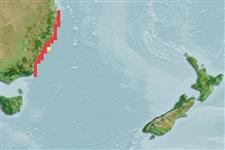Elasmobranchii (sharks and rays) >
Myliobatiformes (Stingrays) >
Urolophidae (Round rays)
Etymology: Urolophus: Greek, oura = tail + Greek, lophos = crest (Ref. 45335).
More on author: Whitley.
Environment: milieu / climate zone / depth range / distribution range
Ecology
Marine; demersal; depth range 45 - 300 m (Ref. 9863), usually 100 - 160 m (Ref. 9863). Temperate; 26°S - 38°S, 149°E - 154°E
Southwest Pacific: Australia, from Queensland to New South Wales. Possibly hybridizes with the largely allopatric banded stingaree Urolophus cruciatus (a more southern species), and perhaps one of the few known cases of chondrichthyan hybridization.
Length at first maturity / Size / Weight / Age
Maturity: Lm ?, range 23 - ? cm
Max length : 42.0 cm TL male/unsexed; (Ref. 9863)
Little is known of its biology (Ref. 6871).
Life cycle and mating behavior
Maturity | Reproduction | Spawning | Eggs | Fecundity | Larvae
Last, P.R. and J.D. Stevens, 1994. Sharks and rays of Australia. CSIRO, Australia. 513 p. (Ref. 6871)
IUCN Red List Status (Ref. 130435: Version 2024-1)
Threat to humans
Harmless
Human uses
Tools
Special reports
Download XML
Internet sources
Estimates based on models
Preferred temperature (Ref.
123201): 14.1 - 21, mean 18.2 °C (based on 11 cells).
Phylogenetic diversity index (Ref.
82804): PD
50 = 0.5000 [Uniqueness, from 0.5 = low to 2.0 = high].
Bayesian length-weight: a=0.00813 (0.00372 - 0.01775), b=3.08 (2.88 - 3.28), in cm total length, based on LWR estimates for this (Sub)family-body shape (Ref.
93245).
Trophic level (Ref.
69278): 3.5 ±0.4 se; based on size and trophs of closest relatives
Resilience (Ref.
120179): Low, minimum population doubling time 4.5 - 14 years (Assuming fecundity<100).
Fishing Vulnerability (Ref.
59153): Low to moderate vulnerability (32 of 100).
